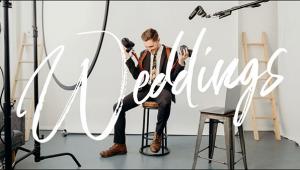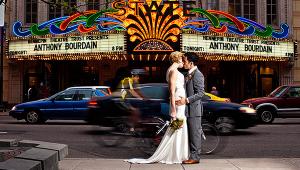It's like having my own wedding, I can almost feel the breeze in the garden setting. - Casa Sandoval
Wedding Photography à la Andy And Brian Marcus: Different Styles Lead To Equally Inspired Results
Andy Marcus and son Brian are second- and third-generation portrait and wedding photographers. Their New York City studio, Fred Marcus Photography & Videography (www.fredmarcus.com), continues a tradition of dedicated service established by Fred Marcus back in 1941. “Back then my dad would use a 5x7 view camera for studio work and could be seen shooting portraits in bridal salons in the prestigious Bergdorf Goodman and Saks Fifth Avenue, among other venues,” Andy recalls. “When he shot weddings, he’d bring a Speed Graphic to the event—and flashbulbs.”

All Photos © Fred Marcus Photography
When Andy joined the studio, the 4x5 still reigned supreme at events. “At some point, we moved on to the Rolleiflex TLR and to roll film, eventually working our way into Hasselblad.” But about seven years ago this father-and-son team sensed the shifting tides, in particular when pro labs catering to the trade refused to process and print film, and made the switch to digital.

One Digital Path, Two Different Roads
When it comes to digital, Andy and Brian saw eye to eye on a shift from medium format to D-SLR. Aside from cost, Andy explains, “Of course we want the highest quality files, but you’re talking about commercial-style cameras for weddings. If you do 200 or 300 weddings a year, you have to factor in the time it takes to edit all those files. The size of the files on these high-end D-SLRs is about as big as we can handle in terms of speed and efficiency.”
That said, father and son moved in different directions when it came to choosing a D-SLR system. Andy opted for the Canon EOS-1Ds Mark III for studio and wedding portraits, the 5D Mark II for candids; Brian gravitated toward the Nikon D3S and D700. The 5D is also the cornerstone of their video work. They shoot Raw exclusively, even at the reception.

The lenses they use somewhat overlap in focal length, although each has his favorites. Image-stabilized lenses also enter the picture. Andy’s lenses of choice are the 70-200mm (for portraiture), the 24-105mm (an all-around solution for candids), the 14mm (to encompass the entire space), and the 100mm macro (for close-ups of rings). Additional lenses include the 90mm tilt-shift for event portraits (“to do something a little different”) and the 24mm f/1.4. Brian opts for the 70-200mm, 24-70mm, and 17-35mm—all f/2.8, along with an 85mm f/1.4 and 105mm macro.

A Mix Of Lighting
Fast optics are often at the heart of their photography so that they can take advantage of the ambiance of a space or capture a mood without disturbing it with artificiality. But, as Brian pointed out, high ISO capability coupled with low noise on today’s cameras is a key factor that lets them shoot without flash or an abundance of light much of the time. In fact, often when they need to throw a little extra light onto a scene, they’ll use not flash but a newly developed Gunlight (a collaborative effort by Brian and fellow wedding photographer John Solano). This is a continuous light source that was originally halogen but will come to market as a focusable, highly efficient LED light suitable for stills and video (www.thegunlight.com; www.tiffen.com). “My assistant uses that throughout the evening for run-and-gun photography,” Brian notes. Andy makes similar use of that light.

In the studio, the Dynalite reigns supreme. But these Dynalites also go on location. “We use it because it is high-quality portable equipment,” Brian points out. And, yes, on-camera flash does make an appearance, used in TTL-Auto mode for the most part. “I use the Nikon SB-900 during the party and a Lumedyne as a hairlight or backlight.” This is a specially modified Lumedyne that outputs a small amount of light so it recycles quickly.

Andy uses the Canon 580EX II during the reception, along with the Lumedyne. “What sets our studio apart from other wedding shooters is that we use multiple lighting for more formal shots. So I put up a couple of Dynalites in most of the ballrooms, sometimes more, depending on the size of the space, and that lights up backgrounds. Our clients may spend thousands of dollars on flowers and they want to see that detail back there.”
Controlling The Light
Andy continues: “For the most part, we don’t use flash outdoors. Instead, we use the 5-in-1 Westcott collapsible reflectors, even with window light. Personally, I like silver.” Brian adds: “I use silver and white, and I like the translucent diffuser to soften harsh, direct sunlight.”
Light shapers used by this team run the gamut from umbrellas for portraits at the event to a softbox in the studio—all Westcott. More to the point, Brian points out that “our lighting in the studio is very simple. It consists of one big softbox, with a large reflector opposite it for fill. Then we use a hairlight as a rim light and a backlight, as needed. Simple lighting clears a path for better interaction with the subject.”

Andy also uses a Sto-fen diffuser on his 580EX II. “I bounce the flash at a 45-degree angle just to get a little fill in the face, and let the other lights do their thing.” Son Brian, on the other hand, shuns bounce lighting in favor of raw flash.
When using Dynalites, they’ll meter with Sekonics. Andy adds: “We set up flash units in the room prior to the reception and meter. Underexposing the background by one stop gives a nice look to our photographs. I try to stay within the f/8 range for most of my party shots.”
To trigger the remote strobes they’ll use PocketWizards. As Brian noted, “I especially like the new PocketWizard MiniTT1 because the transmitter on top of the camera is small, making it easier to have a direct rapport with the subject, especially when you’re shooting children. You don’t have a big transceiver interfering with eye contact. It’s of paramount importance that you always stay connected to your subject.”

Some Wedding Photography Tips
Andy points out that “we use the X-Rite system for balancing all our computers and printers. For white balance, I use a CBL Color Balance Lens (www.cbllensusa.com). So when I set up family portraits in one area, I take a picture of the disc and set it as my custom color balance. I really never have to change my color corrections on the camera, unless I move to a different location. It works in even the strangest lighting situations.”
Brian takes a different tack. “I typically just set my camera white balance to the dominant lighting in the room and go from there. Either way, whether we use that disc or not, we’re refining color balance back in the studio during Raw conversion.”
Brian continues with advice on using on-camera flash: “When I use flash, typically I will turn the ISO up a little bit so the flash doesn’t have to emit as much light as otherwise necessary. That saves on recycle times.
I use rechargeable Energizer batteries for my flashes, replacing them maybe every hour, even if they don’t need to be replaced.”

Finally, Andy provides this insight: “What I’ve tried to teach Brian and the other shooters at our studio is that you don’t have to shoot ‘spray-and-pray’ fashion.” That also means not having to worry about a flash overheating from fast, sequential shooting. “My father taught me that, if something important is happening, then, absolutely, you take three, four, five pictures—no question. But in general most of what we do is waiting for the right moment and focusing on getting that great shot.”
- Log in or register to post comments
















































